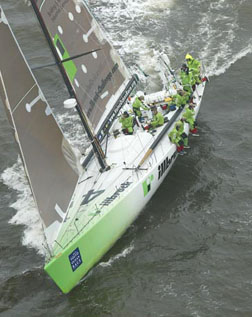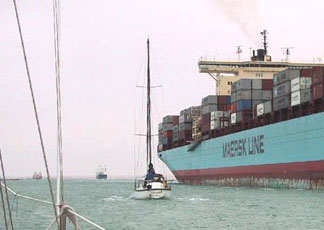Three Men Overboard
May 8 - Santa Cruz
"The recent Moore 24 Nationals at
Santa Cruz featured three days of good racing in mostly 15-20
knot winds and three-foot seas," reports Skip Allan of the
Wylie 28 Wildflower. "You wouldn't think falling
overboard was a serious risk in such conditions, but during Race
3, one of the leading boats did a windward broach while planing
under spinnaker - and two cockpit crew and the helmsman were
flushed overboard. After spending about five minutes in the 52-degree
water, two of the swimmers were recovered by their remaining
two crew, who did a great job in dousing their spinnaker and
making a return. Their helmsman, however, was in trouble and
sinking fast. His race-required lifejacket was not keeping him
afloat, and only the top of his head was visible when I pulled
him alongside using a Life-Sling polypro rope. Being a singlehanded
spectator to the racing, I was unable to lift him aboard amidships,
but did manage to get him aboard via the stern ladder. Despite
coughing up a lot of water, he was recovering well by the time
we reached the dock. But it was a near thing, and in another
minute he may well have sunk for good. I feel the direct cause
was the Musto Regatta lifevest he was wearing did not provide
the minimum flotation to keep him afloat. This popular brand
of lifevest is worn by many sailors primarily for its comfort,
not for its life-saving ability. It is not Coast Guard approved,
and only gives nine pounds flotation when new. It appears the
flotation of bubblewrap filling is subject to deterioration,
especially when hiking hard against lifelines. If you go overboard
wearing cold water sailing gear and boots, this type of lifevest
may not keep you afloat.
"With all the comfortable, Coast Guard
approved, foam filled lifevests now available, it is a mystery
to me why regatta organizers currently allow such non-approved
vests to satisfy their PFD requirement. Judging from the Moore
24 incident, this is a false sense of security and nothing more.
If you or your children rely on such a vest in Northern California
sailing conditions, I would give it a second look. The tragedy
of Larry Klein is too fresh to be forgotten.
"My participation in the recovery was non-heroic, but rather
what any professional seaman would have done in the circumstances.
Nonetheless, it was discouraging to me that about 12-15 racers
passed in proximity to the swimmers, but nobody stopped or came
back, except for the boat that had lost the crew over! The two
excuses that I heard were 'we were going so fast that by the
time we would have doused, we were past them,' and 'we saw other
boats in the vicinity, and thought they were taking care of things.'
I don't wish to make an issue of this separate part of the day's
happenings, other than to point out that the very first racing
rule of Part 1, Fundamental Rules, Rule number 1 is 'A BOAT OR
COMPETITOR SHALL GIVE ALL POSSIBLE HELP TO ANY PERSON OR VESSEL
IN DANGER.' Which brings up an interesting question. At what
point is a person overboard 'in danger?' In the tropics, it may
be one thing, and in 52-degree water with wind waves, it may
be another.
"Interestingly, as I sailed close-hauled
on starboard tack to the scene of the three swimmers, a port
tack tailender, not under spinnaker, came barreling at me, shouting
'get out of the race course!' When I pointed out the swimmers,
they stopped shouting at me - but sped right on by. Again, I
do not wish to criticize the participants in the Moore Class
Nationals, as many are my friends. In the heat of action, sometimes
decisions can get blurred. But lives could have been lost in
this situation."
Can we all agree that any sailor who has
gone overboard in Northern California waters is 'in danger',
and that nobody should ever sail by someone - or group - who
has gone overboard, at least until they are absolutely, positively
certain that a successful rescue is underway?
|




